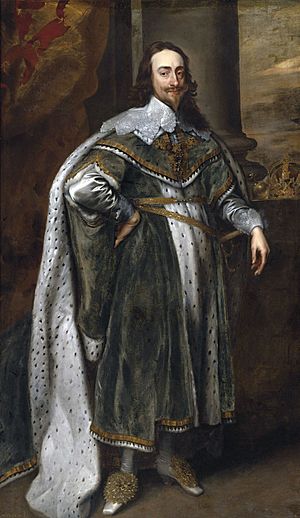Chronology of the Wars of the Three Kingdoms facts for kids
The Wars of the Three Kingdoms were a series of big fights that happened in England, Scotland, and Ireland between 1639 and 1653. They weren't just one war, but several linked conflicts. These wars were mainly about who should have the most power: the King or the Parliament. They also involved big disagreements about religion.
Contents
What were these wars about?
The Wars of the Three Kingdoms included several important conflicts:
- The Bishops' Wars in Scotland.
- The Irish Rebellion and later the Irish Confederate Wars.
- The First English Civil War.
- The Second English Civil War.
- The war between England and Scotland from 1650 to 1652.
- Oliver Cromwell's takeover of Ireland.
- And even smaller fights like Glencairn's Rising in Scotland.
These wars were a really confusing time. People fought over who should rule, what religion should be followed, and how much power different groups should have.
Key Events in the Wars
The wars started because King Charles I wanted to rule without Parliament and tried to make everyone follow the same church rules. This made many people in Scotland and England very angry.
The Bishops' Wars (1639-1641)
The first big fights were in Scotland. King Charles I tried to force a new prayer book on the Scottish Church. The Scots, called the Covenanters, didn't like this.
- In 1639, the Covenanters beat the King's supporters at Brig of Dee.
- In 1640, they won another battle at Newburn.
- Finally, in August 1641, King Charles I had to sign the Treaty of London, which ended the Bishops' Wars. This showed that the King wasn't as strong as he seemed.
The Irish Rebellion (1641)
The King's weakness in Scotland gave ideas to Catholic landowners in Ireland. They wanted more rights and an end to their lands being taken away.
- In October 1641, a group of Irish Catholics tried to take over Dublin Castle. They failed, but the rebellion quickly spread.
- Rebels captured forts and towns, and sadly, there were attacks on Protestant settlers.
- The Irish rebels tried to take Drogheda but failed.
- King Charles sent an important leader, Ormond, to Ireland to deal with the rebellion.
- English soldiers started arriving in Ireland to fight the rebels.
The Irish Confederate Wars (1642-1649)
As the rebellion grew, the Irish Catholics formed their own government called the Irish Confederates. They wanted to protect their religion and lands.
- In May 1642, the Confederates made an important promise called the Confederate Oath of Association.
- They captured St John's Castle in Limerick.
- Meanwhile, more Scottish soldiers arrived in Ulster, Ireland, to help fight the rebels.
- A key Irish leader, Owen Roe O'Neill, returned to Ireland to lead the Confederate army in Ulster.
- In September 1643, the Royalists (King's supporters) and the Confederates agreed to a ceasefire called the Cessation of Arms. But not everyone agreed with it.
The English Civil Wars (1642-1651)
The biggest part of these wars happened in England, between King Charles I and his Parliament.
- In August 1642, King Charles I officially started the First English Civil War by raising his flag at Nottingham.
- The war was fought all over England. Key battles included:
- Edgehill (October 1642): A big battle where neither side truly won.
- Marston Moor (July 1644): A huge victory for Parliament and their Scottish allies. This was a major turning point.
- Naseby (June 1645): Another decisive win for Parliament, led by Oliver Cromwell. This severely weakened the King's army.
- After many defeats, King Charles I surrendered to the Scottish army in May 1646, which ended the First English Civil War.
However, the fighting wasn't over.
- In December 1647, King Charles I made a deal with the Scots, hoping they would help him. This led to the Second English Civil War in 1648.
- Oliver Cromwell and the Parliamentarians quickly put down these new revolts.
- A major battle was at Preston in August 1648, where the Parliamentarians crushed the Scottish "Engagers" (those who supported the King's deal).
- In January 1649, King Charles I was executed. This was a shocking event and England became a Commonwealth, meaning it was ruled by Parliament, not a king.
Cromwell's Conquest of Ireland (1649-1652)
After the King's execution, Oliver Cromwell himself went to Ireland to finish the fight against the Royalists and Confederates.
- In August 1649, Cromwell's army arrived in Dublin.
- He quickly captured Drogheda in September 1649, and then Wexford in October 1649. These were very harsh sieges, and many people were killed.
- Cromwell continued to capture key towns like Kilkenny and Clonmel in 1650.
- By 1652, most of Ireland was under Parliament's control. The last major surrender was Galway in May 1652.
The Anglo-Scottish War (1650-1651)
Even after Charles I's death, the Scots crowned his son, Charles II, as their new king. This led to another war between England and Scotland.
- In September 1650, Cromwell and the English army defeated the Scots at Dunbar.
- The final big battle was at Worcester in September 1651, where Cromwell decisively defeated Charles II and the Scottish army. This effectively ended the main English Civil Wars.
After the Wars
The Wars of the Three Kingdoms had a huge impact. England became a Commonwealth, and later, Oliver Cromwell became the Lord Protector. The wars changed the power balance in all three kingdoms and led to many years of political and social change.
Images for kids



